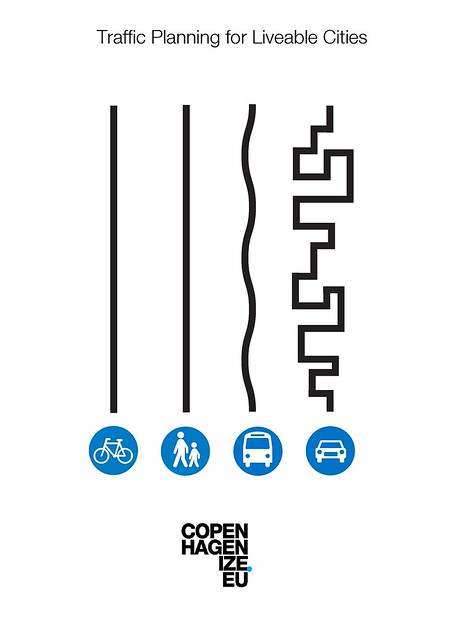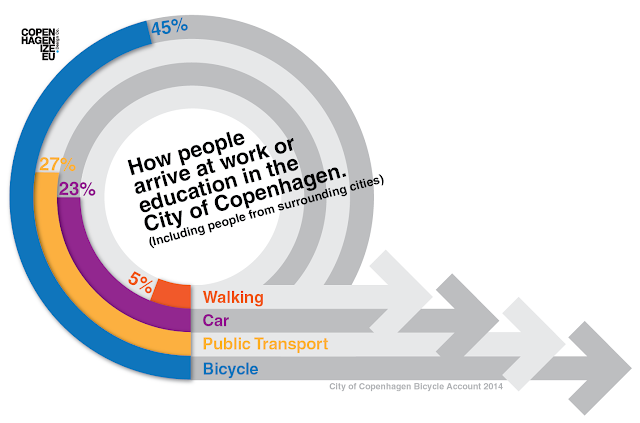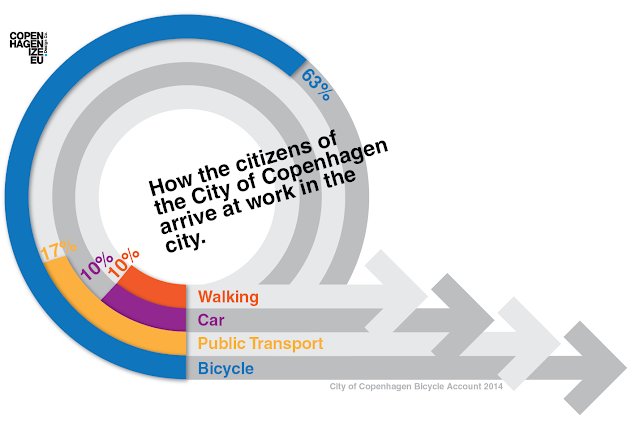
 Right this minute, right here in Copenhagen, what might be the greatest urban transport experiment in the world is well underway. It wasn’t planned but it’s working handsomely. Above is our simple traffic planning guide for liveable cities. Make cycling, walking and public transport the fastest way from A to B and make driving a pain in the ass and you have basically the most effective way to change the mobility paradigm for the better. It’s that simple. All the campaigns for “ride a bike - it’s good for you/it’s green/it’s healthy” are a complete waste of money if you don’t follow the guide. This presupposes protected infrastructure for cycling, of course. Right now in the City of Copenhagen, a new Metro Ring is under construction. We’re not fans of the Metro Ring. A city this size doesn’t need a metro - it needs tramways like so many other cities in Europe. We don’t advocate shoving citizens underground. We want them on street level on foot, on bicycle and in trams. The Metro expansion is a fantastic waste of money. It is projected that cycling levels will fall by around 3% when it’s done. Our colleagues around Europe - especially the Dutch - basically point and laugh when I tell them that we have bus routes with 50,000 passengers a day and the City is building a Metro instead of tramways.
Right this minute, right here in Copenhagen, what might be the greatest urban transport experiment in the world is well underway. It wasn’t planned but it’s working handsomely. Above is our simple traffic planning guide for liveable cities. Make cycling, walking and public transport the fastest way from A to B and make driving a pain in the ass and you have basically the most effective way to change the mobility paradigm for the better. It’s that simple. All the campaigns for “ride a bike - it’s good for you/it’s green/it’s healthy” are a complete waste of money if you don’t follow the guide. This presupposes protected infrastructure for cycling, of course. Right now in the City of Copenhagen, a new Metro Ring is under construction. We’re not fans of the Metro Ring. A city this size doesn’t need a metro - it needs tramways like so many other cities in Europe. We don’t advocate shoving citizens underground. We want them on street level on foot, on bicycle and in trams. The Metro expansion is a fantastic waste of money. It is projected that cycling levels will fall by around 3% when it’s done. Our colleagues around Europe - especially the Dutch - basically point and laugh when I tell them that we have bus routes with 50,000 passengers a day and the City is building a Metro instead of tramways.
The Metro is already falsely advertising the travel times. Advertising station to station, but not the first and last mile to and from the station. We did our own travel time survey using real world scenarios and the bike usually beats the Metro in Copenhagen.
Fine. We don't like the Metro but damn, right now, we love the Metro construction. The City is following the traffic planning guide for liveable cities to the letter. Copenhagen has 17 Metro stations under construction and this is having a massive effect on mobility patterns in the city. Driving is a pain in the ass. What has happened?Cycling levels have stagnated for years in Copenhagen. Hovering between 35% and 38%. Falling from 37% to 35% after intense helmet promotion.
Now there are new numbers from the Danish Technical University's Travel Survey. Between 2012 and 2013, the modal share for bicycles (people arriving at work or education in the City of Copenhagen) exploded from 36% to 45%. Forty-five percent. A leap of 9%. That has never happened anywhere. Ever. Seriously. The car's modal share fell from 27% to 23%. But wait, there's more. The average trip length in Copenhagen rose 35% from 3.2 km to 4.2 km between 2012 and 2013. That means that the oft-quoted statistic about how Copenhageners cycle 1.2 million km a day need to be upgraded to 2,006,313 km per day. Since 1990, by the way, the number of cyclists has risen 70% in Copenhagen. The number of car trips into the city centre has fallen from 350,000 to 260,000.
Between 2012 and 2013, the modal share for bicycles (people arriving at work or education in the City of Copenhagen) exploded from 36% to 45%. Forty-five percent. A leap of 9%. That has never happened anywhere. Ever. Seriously. The car's modal share fell from 27% to 23%. But wait, there's more. The average trip length in Copenhagen rose 35% from 3.2 km to 4.2 km between 2012 and 2013. That means that the oft-quoted statistic about how Copenhageners cycle 1.2 million km a day need to be upgraded to 2,006,313 km per day. Since 1990, by the way, the number of cyclists has risen 70% in Copenhagen. The number of car trips into the city centre has fallen from 350,000 to 260,000.  The 45% number includes people arriving in Copenhagen from surrounding municipalities (there are 22). Among citizens of the City of Copenhagen itself, a whopping 63% use a bike to get to work or education and only 10% drive a car. Another rise in cycling and a drop in car use.
The 45% number includes people arriving in Copenhagen from surrounding municipalities (there are 22). Among citizens of the City of Copenhagen itself, a whopping 63% use a bike to get to work or education and only 10% drive a car. Another rise in cycling and a drop in car use.
Okay, okay. But what does it all MEAN? When the results of the travel survey came out, journalists were scrambling for answers. Two researchers at DTU were "surprised". They were quoted in the Danish press as saying things like, "uh... the City's new bridges and traffic calming on certain streets seem to have worked. Giving cyclists carrots encourage cycling."
The detail they forgot was that the new cycling bridges aren't finished yet, nor is the traffic calming on Amagerbrogade. The Nørrebrogade stretch is from 2008. Cycling rose on that street by 15% but that was BEFORE 2012. Duh. Bascially, there hasn't been much carrot dangling in this city for a few years. So forget about THAT hastily thunk up theory. Things are happening NOW, in 2013 and 2014, sure, but that has nothing to do with the data from 2012 to 2013. Double Duh. What HAS happened is that 17 huge construction sites fell out of the sky all at once. Not something that happens every day. In addition, most of central Copenhagen - between 2012 and 2013 - was under further construction because of the upgrading of district heating pipes under many streets that had to be ripped up. Look at the guide at the top again. THAT is what has happened. Driving was rendered incredibly difficult. Copenhageners, being rational homo sapiens, chose other transport forms. Public transport has increased, too, but the bicycle is clearly the chariot of choice. It's no surprise at all why cycling is booming. What is happening right now is a fantastic urban experiement. So much data and experience is and will become available. Mark my words, however. When the Metro construction is finished in 2018... probably 2019... we will see a sharp drop in cycling levels, back to the standard levels we plateaued with for the past few years. You read it here first.Unless, of course, the City of Copenhagen has the cajones to embrace this experiment and use it to finally make The Leap - as described by author Chris Turner - into the future of our city. Expanding and widening the cycle tracks. Reallocating space from falling car traffic to bicycles and public transport. The new BRT route in Copenhagen is a good step. Let's see how much farther we can go. Designing cities instead of engineering them. The citizens have shown us that they will be on our side if we do the right thing.
Otherwise, this rich petri dish experiment will just rot and be forgotten.




